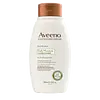What's inside
What's inside
 Benefits
Benefits

 Concerns
Concerns

 Ingredients Side-by-side
Ingredients Side-by-side

Colloidal Oatmeal Extract
HumectantCetyl Alcohol
EmollientCetearyl Alcohol
EmollientBehentrimonium Chloride
PreservativeGlycerin
HumectantSteareth-20
CleansingPPG-3 Benzyl Ether Myristate
EmollientHydrolyzed Milk Protein
Skin ConditioningPrunus Amygdalus Dulcis Seed Extract
Skin ConditioningAmodimethicone
Polyquaternium-47
Skin ConditioningPolyquaternium-37
PPG-1 Trideceth-6
Skin ConditioningPropylene Glycol Dicaprylate/Dicaprate
EmollientWater
Skin ConditioningIsopropyl Alcohol
SolventDisodium EDTA
Citric Acid
BufferingSodium Hydroxide
BufferingSodium Benzoate
MaskingParfum
MaskingColloidal Oatmeal Extract, Cetyl Alcohol, Cetearyl Alcohol, Behentrimonium Chloride, Glycerin, Steareth-20, PPG-3 Benzyl Ether Myristate, Hydrolyzed Milk Protein, Prunus Amygdalus Dulcis Seed Extract, Amodimethicone, Polyquaternium-47, Polyquaternium-37, PPG-1 Trideceth-6, Propylene Glycol Dicaprylate/Dicaprate, Water, Isopropyl Alcohol, Disodium EDTA, Citric Acid, Sodium Hydroxide, Sodium Benzoate, Parfum
Water
Skin ConditioningVanilla Planifolia Fruit Extract
Skin ConditioningPropylene Glycol
HumectantCitrus Aurantium Dulcis Peel Cera
EmollientSodium Cetearyl Sulfate
CleansingFragaria Vesca Seed
AstringentParfum
MaskingCetearyl Alcohol
EmollientHoney
HumectantLanolin
EmollientSalvia Sclarea Oil
MaskingLavandula Angustifolia Oil
MaskingStyrax Benzoin Gum
MaskingCetrimonium Chloride
AntimicrobialPhenoxyethanol
PreservativeBenzyl Alcohol
PerfumingAlpha-Isomethyl Ionone
PerfumingCoumarin
PerfumingWater, Vanilla Planifolia Fruit Extract, Propylene Glycol, Citrus Aurantium Dulcis Peel Cera, Sodium Cetearyl Sulfate, Fragaria Vesca Seed, Parfum, Cetearyl Alcohol, Honey, Lanolin, Salvia Sclarea Oil, Lavandula Angustifolia Oil, Styrax Benzoin Gum, Cetrimonium Chloride, Phenoxyethanol, Benzyl Alcohol, Alpha-Isomethyl Ionone, Coumarin
Ingredients Explained
These ingredients are found in both products.
Ingredients higher up in an ingredient list are typically present in a larger amount.
Cetearyl alcohol is a mixture of two fatty alcohols: cetyl alcohol and stearyl alcohol. It is mainly used as an emulsifier. Emulsifiers help prevent the separation of oils and products. Due to its composition, it can also be used to thicken a product or help create foam.
Cetearyl alcohol is an emollient. Emollients help soothe and hydrate the skin by trapping moisture.
Studies show Cetearyl alcohol is non-toxic and non-irritating. The FDA allows products labeled "alcohol-free" to have fatty alcohols.
This ingredient is usually derived from plant oils such as palm, vegetable, or coconut oils. There is debate on whether this ingredient will cause acne.
Due to the fatty acid base, this ingredient may not be Malassezia folliculitis safe.
Learn more about Cetearyl AlcoholParfum is a catch-all term for an ingredient or more that is used to give a scent to products.
Also called "fragrance", this ingredient can be a blend of hundreds of chemicals or plant oils. This means every product with "fragrance" or "parfum" in the ingredients list is a different mixture.
For instance, Habanolide is a proprietary trade name for a specific aroma chemical. When used as a fragrance ingredient in cosmetics, most aroma chemicals fall under the broad labeling category of “FRAGRANCE” or “PARFUM” according to EU and US regulations.
The term 'parfum' or 'fragrance' is not regulated in many countries. In many cases, it is up to the brand to define this term.
For instance, many brands choose to label themselves as "fragrance-free" because they are not using synthetic fragrances. However, their products may still contain ingredients such as essential oils that are considered a fragrance by INCI standards.
One example is Calendula flower extract. Calendula is an essential oil that still imparts a scent or 'fragrance'.
Depending on the blend, the ingredients in the mixture can cause allergies and sensitivities on the skin. Some ingredients that are known EU allergens include linalool and citronellol.
Parfum can also be used to mask or cover an unpleasant scent.
The bottom line is: not all fragrances/parfum/ingredients are created equally. If you are worried about fragrances, we recommend taking a closer look at an ingredient. And of course, we always recommend speaking with a professional.
Learn more about ParfumWater. It's the most common cosmetic ingredient of all. You'll usually see it at the top of ingredient lists, meaning that it makes up the largest part of the product.
So why is it so popular? Water most often acts as a solvent - this means that it helps dissolve other ingredients into the formulation.
You'll also recognize water as that liquid we all need to stay alive. If you see this, drink a glass of water. Stay hydrated!
Learn more about Water